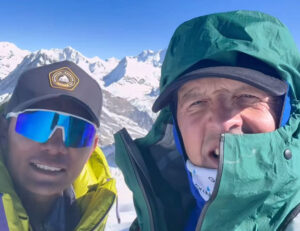But it strengthens the criteria for future Manaslu summits.
This season, Mingma G and some remarkable drone footage from Manaslu have spurred a lively debate. The climber and his team left everyone else behind to pursue the mountain’s actual highest point.
Through Jackson Groves’ drone footage, some climbers are scratching their heads and reviewing their Manaslu “summit” pictures in a new light. They are also, finally, checking 8000ers.com for detailed information about Manaslu’s summit area.
Surprisingly, very few climbers have contacted ExplorersWeb to claim that they reached the true summit. Speaking off the record, some climbers explained that they climbed past the end of the fixed ropes and reached a point where “everywhere [they] looked was down”, but are now having second thoughts. It begs the question: Over the past 40 years of fall climbing on Manaslu, how many have reached the true summit?
Most climbers, including those whose historical records might be affected, are keeping a discreet silence. They have been waiting for an authority to weigh in. Namely, they were waiting for the Himalayan Database, a non-profit founded by the late Elizabeth Hawley, to decide what it will consider a Manaslu summit moving forward, and what it will do about previous summit claims.
The Himalayan Database weighs in
Today, the Himalayan Database posted its conclusion. Whether their decision will settle things or further fuel the debate remains to be seen.
“With the clearly documented summit success of Mingma Gyalje and his team, the Himalayan Database has decided that from 2022, it will only credit the summit to those who reach the highest point shown in the drone picture taken by Jackson Groves,” they have stated. “Those who reach the tops shown as Shelf 2, C2, and C3 in the picture [shown below] will be credited with the foresummit.”
The Himalayan Database team added that they made the change with the support of “foreign and Nepali operators” they had consulted in Kathmandu.
The news is no surprise to anyone who has seen the pictures. They leave no room for doubt about where the peak’s highest point lies, and Mingma G has shown the way to reach it.

The Himalayan Database will accept past summits according to a rather wide zone of tolerance. Photo: Jackson Groves
Past expeditions
For past expeditions, the Himalayan Database has opted for a simple, diplomatic solution: to leave things unchanged.
“As we cannot change history, we will make a note in the database that from 1956 — when the summit was first reached by Toshio Imanishi and Gyaltsen Norbu Sherpa — to 2021, we accepted the three points mentioned above as the summit due to a lack of in-depth knowledge,” the report says.
Eberhard Jurgalsky and the 8000ers.com team have taken a different position. Discussing possible zones of tolerance on Manaslu, 8000ers.com proposes one list for climbers who reached the C2 and C3 foresummits, and another for those who actually reached the top. For those reaching the “shelf” and C0, they would not grant summit status.
“Yes, it changes history, but better change than just [be] wrong,” 8000ers.com stated.
Others in the mountaineering community have also opted for a strict position. Swedish climber Fredrik Sträng shared a long, honest report. After carefully checking 8000ers.com documentation, he has deleted Manaslu from his summit list.
“It is now clear to me that I did not summit Manaslu’s true/main summit back in autumn 2015, and in fact, none of the around 80 climbers did,” he said. “It is in every mountaineer’s interest to know where the summit is and if one has attained it,” he added. “Why else spend thousands of hours training and spend countless money on giant peaks?”
This brings up attitude. Some climbers reached a point, sometimes well past the end of the fixed ropes, that they believed was the true summit. Others simply stopped at a comfortable photo spot once the ropes ended. Unfortunately, it is impossible to tell who chose an easy endpoint and who genuinely tried to reach the true summit. The truth lies in the heart and mind of each Manaslu climber, out of reach of the statisticians.





